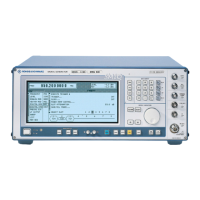Bit Error Rate Test SMIQ
1125.5555.03 2.374 E-9
2.23.1.3 Test Method
Generation of PRBS
data
PRBS data are generated with the aid of a shift register with feedback points
determined by the polynomial. A random start status yields one subsequent
state. The start status and therefore the subsequent status occur only once in
the whole sequence.
Feedback of data
stream
If the shift register is filled with a data sequence at the beginning of a
measurement and the register is then switched from "filling" to "feedback",
the register generates the same data sequence as it expects to receive.
Faulty bits can thus be identified and counted by comparing the received data
to the results obtained from the shift register.
This method has the advantage that the analyzer can be used separately
from signal generation (logically and with respect to time). Consequently,
delays caused by the DUT, the use of other PRBS sources and transmission
over long distances with spatially separated transmitter and receiver, do not
cause any problems.
Errors in start status
If a bit error is already present in the start status (faulty bits are not detected
during filling), the shift register starts from an incorrect position in the data
sequence. As a result all subsequent states will be faulty. Since, statistically,
every second bit is faulty, the BER will be about 50%. In this case the
measurement is started again automatically, without the user realizing.
BER measurement
with uninterrupted
repetition of the
random sequence
The (non-integrating) BER measurement operates on the basis of random
sequences that are run continuously. These sequences are either generated
continuously or by cyclic output of a stored sequence, with the number of
encoded bits being an integer multiple of the length of the random sequence.
The length of the random sequence is 2 to the power of the degree of the
polynomial less 1, ie PRBS9 has a length of 511 (2
9
equals 512 less 1).
This type of BER measurement is selected by either setting External Restart to
DISABLED or by issuing the IEC/IEEE-bus command :BERT:SET:REST INT.
The CLOCK and DATA lines are sufficient for this measurement.
The data to be
analyzed are
interrupted by other
data
The data bits contain data like sync, preambles, other channels, etc in
addition to the PRBS data. To mark the data to be evaluated, a DAT ENABle
signal has to be sent with the data. Either this DAT ENABle signal is
generated by the DUT or an additional channel of the IQ source is used (eg
marker channel of AMIQ).
The BER measurement in the SMIQ has to be adjusted for the use of a DAT
ENABle signal; this is done by setting the required polarity in the menu or by
means of IEC/IEEE-bus command (:BERT:SET:DEN Low|High). Data
Enable = high means that data are only counted by the DUT and subjected to
the BER measurement if the data enable input is set to 1.

